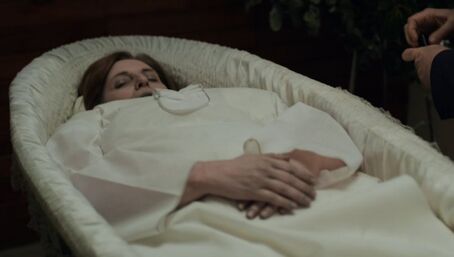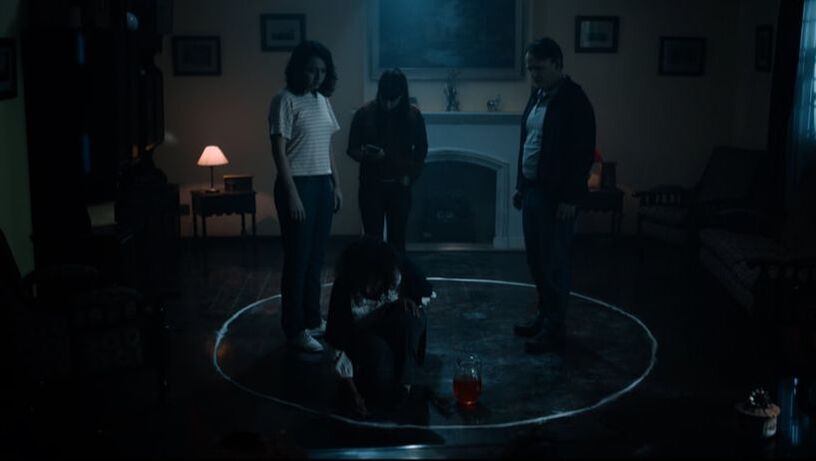 Death can be a risky business. CareerTrend estimates that funeral homes can earn up to $60,000 a year depending on location and business... ...But you can only be around the dead for so long before the dead begin to reach out and make themselves known, and writer/director Mauro Iván Ojeda’s The Funeral Home (aka La Funeraria) tells just such a story. This Argentinian tale centers on Bernardo (Luis Machín), an undertaker who lives in and runs his own funeral home. While it may sound unsettling to those of us on the outside, living where they work is not entirely uncommon among those in the business of death. I’ve been to several funeral homes that have a residential area for the undertakers to live, sometimes even in the same building. I was glued to the screen from the film’s opening shot, a seemingly continuous sweep from room to room. As the camera wanders, you are offered glimpses into the level of effort and detail that went into the set design to make this funeral home feel like an actual home. Bernardo has inherited the funeral home from his father and now lives among his clientele along with his wife Estela (Celeste Gerez) and their teenage stepdaughter Irina (Camila Vaccarini). We are tipped off that things may not be altogether right with the house thanks to Estela’s disheveled appearance at the film’s beginning. Her disorder mirrors the uneasiness outside the residential area, awash at night with pulsating lights and eerie feelings that hint at some strange goings-on. Perhaps what sets The Funeral Home/La Funeraria apart from other ghost stories is that the family knows from the beginning that something is not right with the house. There is little room for doubt as Bernardo receives cryptic messages and Estela feels unsettled in the bath, as if someone or something was watching her. The use of flickering lights is a mainstay in the paranormal genre; the spirits of the recently or bygone deceased have always used technology in every shape and form to communicate with us. Ojeda uses this signal as a cue to the audience that ghosts or spirits are present, much like M. Night Shyamalan tipped us off with the use of the color red in The Sixth Sense. The spirits manifest themselves in relatively subtle ways, from hands reaching through a chained door to a sinister black claw reaching for a ball. It’s a little hard to believe this is Ojeda’s first feature. His impressive ability to build tension with every scene keeps you glued to the screen through its entire 86-minute runtime. Beyond the writing and directing, the core performances of the three actors make this one of the best ghost stories of the new year. Luis Machín’s Bernardo comes off as very aloof at first, but as the film progresses, we see that he is not afraid to interact with the spirits around him even if that could spell disaster for the rest of his family. There are moments, thanks in part to Machín’s performance, where Bernardo feels like a curious child interacting with the spirits, even as a grown man. The little moments where the camera lingers on Bernardo’s face bring Machín’s abilities to the forefront as we watch his sense of wonder, fear, and desperation that suggest he may not be the first undertaker to fall under the specters’ spell. Celeste Gerez's performance as Estela feels the strongest of the three. She portrays Estela as a woman dealing with the lingering impact of her previous abusive relationship while trying to balance maintaining the house and dealing with all of its strange goings-on. Gerez does so much with so little. She has a remarkable ability to convey the sheer fear and anxiety her character goes through in a glance of her eyes, and her body language effectively communicates how Estela is feeling in any given moment. Rounding out the troop is Camila Vaccarini’s performance as Irina. While she could’ve played the role as your typical annoying bratty teen, instead we get the sense that Irina is just a victim of circumstance caught between the mother who loves her and the grandmother that wants to manipulate her and ensure she is with her father. Her performance by the end of the film is amazing, evolving from skeptical to devastating as the final act ensues. It isn't until the hour mark, however, that Ojeda spins this ghost story on its head with a unique form of storytelling. The family hires a sort of psychic/shaman to investigate the going ons in the house and we are given an almost dreamlike sequence, complete with hazy lighting. The story’s third act is the highlight of the film; the action is at its peak and tension builds with every second. Filling out that tension is the fantastic score by Jeremias Smith. There’s synth sprinkled throughout but it's the strong strings in the pieces that make your heart skip a beat. There are moments where the violins’ high notes make the hairs on your skin stand instinctively. I was honestly floored that this was Smith’s first feature as well; his strong ear for composing tension made his work one of the highlights of the film. The Funeral Home/La Funeraria is more than a ghost story; it's a familial drama. The phrase “you reap what you sow” kept popping into my head in the end as I watched the truth behind the happenings in the house come to light, and I was floored by how quickly and drastically things turned. The ending is devastatingly heartbreaking and left me in tears. This is a film for anyone that loves a good paranormal thriller that prefers to chuck you in the deep end and hope that you can swim rather than hold your hand. The Funeral Home/La Funeraria will no doubt go down in the books as a highlight in Latin horror. I highly recommend this one even for people who may be apprehensive about foreign language horror. It will surely win you over…and may even scare you to death. The Funeral Home/La Funeraria comes to VOD February 2nd from Uncork’d Entertainment. By Kalani Landgraf
0 Comments
Leave a Reply. |
Archives
March 2023
|


 RSS Feed
RSS Feed